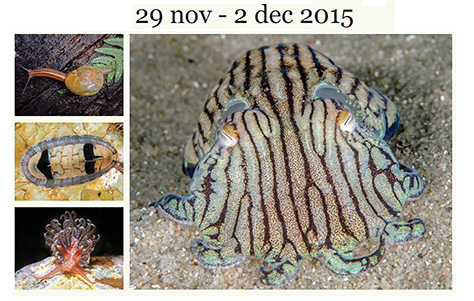Molluscs 2015

Download the Molluscs 2015 Program and Abstract Handbook
Conference Report:
The triennial conference of the Malacological Society of Australasia Molluscs 2015 was held at the Pacific Bay Novotel Conference Centre and National Marine Science Centre from 28th November until 2nd December, 2015. Due to the outstanding array of abstracts for innovative research presentations, we named the conference Molluscs 2015: Frontiers in Molluscan Research. There were plenary (key note) presentations each morning and concurrent contributed sessions on Monday and Tuesday afternoon. In total we had 6 keynote presentations and 48 contributed oral presentations. On Wednesday afternoon we hosted the annual general meeting of the Malacological Society of Australasia (MSA), followed by a tour of the NMSC research facilities and then a panel discussion on “Future Directions for Molluscan Research”.
A post conference tour to Dorrigo National Park was run on 3rd Dec. The dive trip to the Solitary Islands had to be cancelled due to inclement weather conditions, however a supplementary trip to the intertidal reef at Woolgoolga Headland was run on 3rd December, led by Assoc. Prof Steve Smith. A post-conference nudibranch workshop was run from 4-5th December at the National Marine Science Centre, led by Dr Richard Willan Senior Curator and expert nudibranch taxonomist from the Museum and Art Gallery of the Northern Territory. Participants included a range of academic researchers, postgraduate students and selected members of the general community involved in “citizen science” programs. The opening keynote speaker was Dr Tony Rees winner of the 2014 Ebbe Nielsen Prize for Excellence in Biodiversity Informatics. His presentation was an excellent start to the conference, with a timely summary of progress in biodiversity databases and online mapping tools of relevance to all taxonomists and biodiversity researchers. This was followed by Symposia on “Human Impacts and Evolution”, “Climate Change” and “Phylogeography and Evolution”, with further a Symposium on “Biodiversity and Biogeography” the following day. Overall, these presentations highlighted a number of key issues and some
solutions for molluscan conservation and management. Furthermore, the last plenary session of the conference was on “Biodiversity and Citizen Science”. This session highlighted the effectiveness of using molluscs in community monitoring programs and the value of involving citizens scientists in such programs for long-term data collection.
Molluscs 2015 also included dedicated Symposia on “Bioresources: Molecular Innovations” and “Bioresources: Fisheries and Aquaculture”. This included keynote presentations from Dr Bob Creese, Director of Fisheries Research who outlined his fascinating journey from research into molluscan life histories in New Zealand to the challenges of conserving marine biodiversity in NSW and Dr Karina Hall, Fisheries Resource Assessment Scientist, NSW DPI who provided an interesting overview of the current status of eastern Australian cephalopod fisheries and revised methods for ecological risk assessment. The final keynote presentation by Dr Karen Cheney, UQ, provided a fascinating insight into the evolution of colour in nudibranchs with respect to how colour patterns are perceived by their potential predators and co-evolution with chemical defense and palatability.
During the final conference panel discussion on “Future Priorities for molluscan research” we discussed ways of increasing the profile and understanding of molluscs within the general community by developing educational resources. Other priorities that were discussed included ongoing support for taxonomy and training new taxonomists, research into new and emerging diseases, as well as expertise in disease diagnostics, as well as more research on endemic land snails. Dr Wayne O’Connor also provided significant input as a panel member for the Future Priorities of Molluscan Research discussion by highlighting potential funding sources and the need for more collaboration between government and universities.
The quality of all 22 of the student presentations was outstanding and the judges had very tough decisions to make. However, there was unanimous agreement on the overall winner Gustav Kessel (University of Wellington) for his presentation on the carry over effects of global climate change stressors between life stages and generations in Siphonaria. Three equal run-ner up prizes were awarded to: Matt Nimbs (Southern Cross Uni) for his presentation on the application of a cyclical model to assess seasonality in heterobranch sea slug assemblages; Sarah Jacquet (Macquarie Uni) for her presentation on taphonomic constraints in the fossil record and new lower Cambrian macromolluscs from South Australia; and David Rudd (Flinders Uni) for his presentation on the application of an innovative new mass spectrometry imaging procedure to reveal new biological roles for choline esters and Tyrian purple pre-cursors in the reproduction of muricid molluscs. De-spite only a few poster entries this year, the judging pan-el also all agreed that the contribution from Iva Popovic (University of Qld) on evolutionary genomics in invasive Mytilus was deserving of the best student poster award.
The National Marine Science Centre provided an opportunity to show-off some of the local research facilities, which impressed all participants from interstate and overseas. The spectacular location of the conference in the Pacific Bay Resort, and more generally the broader Coffs Harbour region was appreciated by all conference delegates.
~ Kirsten Benkendorff, Scientific Program Chair of Molluscs 2015


